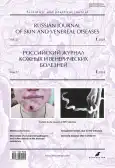Photogallery. Anogenital herpes due to HIV infection
- Authors: Prozherin S.V.1
-
Affiliations:
- Sverdlovsk Regional Center for Prevention and Control of AIDS
- Issue: Vol 27, No 1 (2024)
- Pages: 109-116
- Section: PHOTO GALLERY
- Submitted: 23.11.2023
- Accepted: 13.01.2024
- Published: 12.01.2024
- URL: https://rjsvd.com/1560-9588/article/view/623788
- DOI: https://doi.org/10.17816/dv623788
- ID: 623788
Cite item
Abstract
In patients with HIV infection, especially in the early stages and with preserved immunity, the same clinical manifestations of anogenital herpetic viral infection are observed as in immunocompetent individuals. As human immunodeficiency virus-associated (HIV) immunosuppression worsens in patients not taking antiretroviral therapy, the likelihood of developing atypical, disseminated forms of herpetic lesions increases. In severe immunodeficiency, the course of anogenital herpetic viral infection becomes more persistent, extensive, deep, long-term non-healing erosive and ulcerative rashes often develop, often spreading beyond their typical localization sites. In people living with human immunodeficiency virus with CD4+ T-lymphocyte counts below 50 cells/μl, erosions and ulcers caused by herpes simplex virus types 2 and/or 1 are often detected in the perianal area. In case of an atypical clinical picture, the diagnosis of anogenital herpetic viral infection is made based on the results of laboratory tests. The diagnostic standard is the detection of herpes simplex virus in scrapings from rashes using molecular genetic methods. In hypertrophic, tumor-like forms of the lesion, histological examination may be required.
All patients presented in the photo gallery are human immunodeficiency virus positive. He established the diagnosis of anogenital herpes based on the detection of one or simultaneously two types of herpes simplex virus in biomaterial from lesions using the polymerase chain reaction method. The explanations to the images indicate the stage and phase of human immunodeficiency virus infection in accordance with the Russian clinical classification, as well as the level of CD4+ T-lymphocytes at the time of diagnosis of anogenital herpetic viral infection.
Full Text
About the authors
Sergey V. Prozherin
Sverdlovsk Regional Center for Prevention and Control of AIDS
Author for correspondence.
Email: progsherin@mail.ru
ORCID iD: 0000-0001-9956-4700
SPIN-code: 5354-4893
Scopus Author ID: 57221442199
dermatovenereologist
Russian Federation, EkaterinburgReferences
Supplementary files





















